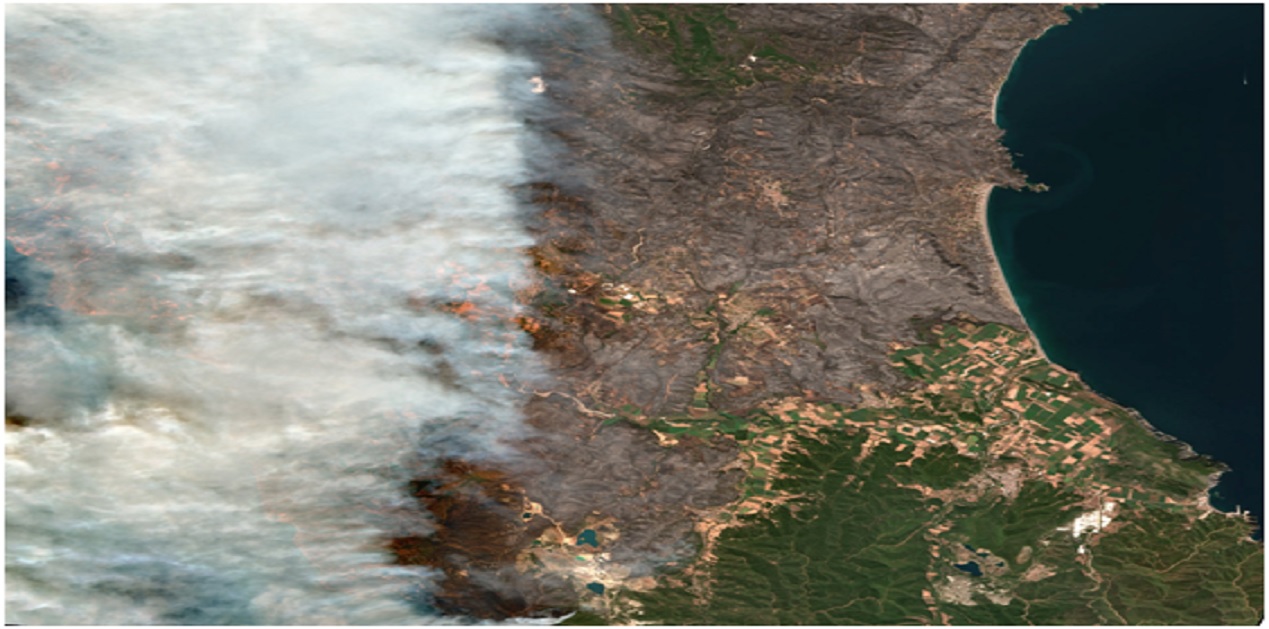Introduction
This article analyzes some of the key findings of the latest scientific reports from the Intergovernmental Panel on Climate Change (IPCC), the world’s leading authority on climate science, as well as those from leading researchers in the field. It also analyzes key developments that occurred throughout 2021 such as record-breaking temperatures, greenhouse gas emissions and extreme weather events. Finally, it summarizes the key outcomes of the United Nations Climate Change Conference (COP26) that was held in Glasgow, the United Kingdom from 31 October to 12 November 2021 and offers a preview of what lies ahead in 2022.
Stark Findings and Gloomy Predictions about the Earth’s Climate System
On 9 August 2021, IPCC released the first installment of its much anticipated Sixth Assessment Report titled Climate Change 2021: The Physical Science Basis. The report, which was approved by 195 governments and based on more than 14,000 studies, represented the world’s full knowledge to date of the physical basis of climate change. It tied climate change more definitively to human influence than ever before, observing with a high degree of certainty that “human influence” has unequivocally warmed the planet at a rate that is “unprecedented in at least the last 2000 years.”[1] This view was echoed by a study that was published in September 2021. The study surveyed nearly 90,000 climate-related scientific papers published from 2012 to 2020 and concluded that the scientific consensus that humans are altering the climate has passed 99.9 per cent.[2] Mark Lynas, the study’s lead author, observed that “It is really case closed. There is nobody of significance in the scientific community who doubts human-caused climate change.” [3] The IPCC report further observed that climate change has already affected every inhabited region across the globe and warned that some of its impacts are now inevitable and “irreversible.” In fact, according to a study that was published in October 2021, climate change has affected 80 per cent of the Earth's land area where 85 per cent of global population lives.[4] The report also projected global warming to hit 1.5°C “in the early 2030s.” That level of warming has long been considered a critical threshold beyond which the worst impact of climate change would intensify. It is therefore a key goal of global efforts to combat climate change such as the Paris Agreement. Signed by 196 countries during the 21st meeting of the United Nations Framework Convention on Climate Change’s (UNFCCC) Conference of the Parties or COP21 in Paris on 12 December 2015, the Paris Agreement called for “holding the increase in the global average temperature to well below 2°C above pre-industrial levels and pursuing efforts to limit the temperature increase to 1.5°C…” by the end of 2100 in order to “significantly reduce the risks and impacts of climate change.”[5]
Although the IPCC’s Sixth Assessment Report painted bleak pictures about the current and future state of the Earth’s climate system, it also offered cautious optimism regarding humanity’s ability to limit global warming to 1.5°C by the end of 2100. It observed with a high degree of certainty that net-zero emissions could reverse some aspects of climate change trends including global warming within a few years. Permafrost thawing on the other hand would take decades to reverse. Meanwhile, acidification of the deep ocean and sea level rise would take centuries and millennia to reverse. Reaching net-zero emissions entails first and foremost reducing human-caused emissions (such as those from fossil-fueled vehicles and factories) as close to zero as possible. Any remaining greenhouse gases should then be balanced with an equivalent amount of carbon dioxide (CO2) removal, which can happen through actions like restoring forests or using direct air capture and storage technology. As regard to the timeline for achieving net-zero emissions, the IPCC observed in an earlier report published in 2018 that it is between 2044 and 2052 for CO2 and between 2063 and 2068 for other greenhouse gases.[6]
Record-breaking Temperatures, Greenhouse Gas Emissions, and
Extreme Weather Events
2021 witnessed record-breaking temperatures, greenhouse gas emissions and extreme weather events. According to preliminary analysis of satellite measurements by Copernicus, the European Union’s climate agency, atmospheric concentrations of CO2 reached an annual record of approximately 414.3 parts per million (ppm) in 2021 with April recording the highest monthly concentrations of 416.1 ppm. To put this into context, the amount of CO2 in the atmosphere before the Industrial Revolution and large scale burning of fossil fuels was 280 ppm. Meanwhile, atmospheric concentrations of methane (CH₄), a more potent but shorter-lived gas that trap heat in the atmosphere 80 times more effectively than CO2, also reached an annual record of approximately 1,876 parts per billion (ppb) in 2021. As regard to the total volume of atmospheric concentration of greenhouse gases, the IPCC’s Sixth Assessment Report observed that in 2019, atmospheric concentrations of CO2 were higher than at any time in at least 2 million years and that of CH₄ and nitrous oxide (N₂O), another potent greenhouse gas, were higher than at any time in at least 800,000 years. It is therefore certain that atmospheric concentrations greenhouse gases will continue to increase with potentially dire consequence for the Earth’s climate system.
A number of national, regional and global temperature records were also broken in 2021. Ten countries - Canada, Dominica, Italy, Morocco, Oman, Taiwan, Tunisia, Turkey, UAE and USA - broke or tied their national highest record.[7] They are as follows: 51.8°C - Swiehan, UAE, 6 June (Tied national record). 51.6°C - Joba, Oman, 16 June (New national record). 49.6°C - Lytton, Canada, 29 June (New national record). 54.4°C - Furnace Creek, USA, 9 July (New world record). 49.6°C - Sidi Slimane, Morocco, 10 July (Tied national record temperature). 48.8°C - Syracuse, Italy, 20 July (New national record). 49.1°C - Cizre, Turkey, 20 July (New national record). 40.6°C - Taimali, Taiwan, 11 August (New national record). 50.3°C - Kairouan, Tunisia, 11 August (New national record). 35.8°C - Canefield, Dominica, 12 August (New national record). Besides, 107 countries surpassed their monthly high temperature record and five surpassed their monthly low temperature record that year. Furthermore, a few continental and planetary records have also been surpassed. For example, Africa recorded its warmest June and September ever. Syracuse in Italy recorded 48.8°C in August, Europe’s highest ever. Meanwhile, Furnace Creek in the USA recorded 54.4°C in July, the highest ever recorded on Earth. Despite this, 2021 was not the warmest year on record due to the influence of La Niña, a periodic climatic feature that cools waters in the Pacific Ocean. As such, the global average temperature in 2021, as recorded by Copernicus, was 1.1-1.2°C above the pre-industrial level of 1850-1900. That made 2021 the fifth hottest year ever recorded by Copernicus - 0.3ºC hotter than its 1991-2020 baseline.[8] Besides, Copernicus also observed that the seven hottest years on record were the last seven. Meanwhile, global average temperature in 2021, as recorded by the National Aeronautics and Space Administration (NASA) and the National Oceanic and Atmospheric Administration (NOAA) in the USA, was 1.1°C above pre-industrial levels. That made 2021 the sixth hottest year ever recorded by NASA and NOAA - 0.84ºC hotter than its 1901-2000 baseline.[9]
Extreme weather events, another key indicator of climate change, also continued unabated in 2021 with record-setting heat waves, wildfires and floods being some of the key highlights. From late June through mid-July, a “one-in-a-thousand-year” heat wave that was dubbed “the mother of all heat waves”[10] struck the western Pacific Coast of the USA and Canada killing hundreds of people in both countries. Scientists said that the extraordinary heat wave was “virtually impossible without human-caused climate change.”[11] Meanwhile, wildfire ravaged parts of Spain, Italy, Greece and Turkey destroying homes and vital infrastructure. Siberia too endured record-breaking wildfire bigger than all the world’s other fires combined. Meanwhile, catastrophic flooding battered China’s Henan province in July killing more than 300 people. That same month, Germany, Belgium, Luxembourg, the Netherlands and Switzerland also experienced deadly flooding that killed about 200 people. Swiss Re, the world’s biggest reinsurer, estimated the total economic losses from extreme weather events in 2021 at USD 250 billion.[12]
Meanwhile, Christian Aid, a British aid group, estimated that the 10 most expensive extreme weather events in 2021 each caused over USD 1.5 billion of damage and a combined cost of USD 170 billion.[13] The most expensive extreme weather event was Hurricane Ida in the USA. It caused around USD 65 billion in damage. Flooding in Germany, Belgium and other parts of Western Europe comes second at USD 43 billion in damage. A cold snap and winter storm in Texas, USA was third at USD 23 billion in damage followed by flooding in China’s Henan province that cost an estimated USD 17.6 billion in damage. Other disasters costing several billion dollars in 2021 included flooding in Canada, a late spring freeze in France, and a cyclone in India and Bangladesh. The scientific consensus is that extreme weather events will see a significant jump in the years ahead with a corresponding increase in economic damages.
COP26 and the Scramble to Limit Global Warming to 1.5°C by the end of 2100
Stark findings about the current state of global climate and gloomy predictions about its future coupled with record-breaking greenhouse gas emissions, temperature, and extreme weather events throughout 2021 provided an unsettling backdrop to that year’s much anticipated UN climate change conference or COP26. Held in Glasgow in the UK from 31 October to 12 November, COP26 was widely considered the best and probably the last chance to limit global warming to 1.5°C by the end of 2100. And it delivered some major successes. For example, many agreements were forged during the conference including a pledge to cut emissions of methane by 30 per cent between now and 2030. And in a reflection of the growing recognition of nature’s role in helping to address global warming, an agreement to end deforestation by 2030 has also been secured. Progress has also been made on climate finance which has been in a limbo ever since developed countries committed in 2019 to provide USD 100 billion a year beginning in 2020 until 2025. Besides, a flurry of net-zero announcements have been made by countries ahead of and during COP26. In all, more than 140 countries covering 90 per cent of global emissions have committed to long-term net-zero emissions target by 2050 and beyond. COP26 also produced the Glasgow Climate Pact that acknowledged the central role of fossil fuels in causing climate change, a first for any COP-type conference.[14] Crucially, the Glasgow Climate Pact formally recognized the need to reduce global greenhouse-gas emissions by 45 per cent by 2030 and to achieve net-zero emissions around mid-century in order for the world to have a chance of limiting global warming to 1.5°C by the end of 2100.
In light of this, did COP26 achieve its key objective of limiting global warming to 1.5°C by the end of 2100? That ultimately hinges on the short-term pledges or Nationally Determined Contributions (NDCs) submitted by countries ahead of and during the conference. NDCs are national plans for climate action that are usually pegged to 2030. At least 194 countries have submitted their first NDCs to the UNFCCC in 2015.[15] However, based on those submissions, the world was projected to warm by 3.2°C by the end of 2100. [16] Countries are obliged to submit new, updated and more ambitious NDCs every five years thereafter i.e. by 2020, 2025, 2030 etc. As such, 120 countries submitted new or updated NDCs ahead of and during COP26.[17] However, an analysis by Climate Action Tracker found that several countries such as Australia, Indonesia, Russia, Singapore, Switzerland, Thailand and Vietnam have only resubmitted the same target as 2015. Others such as Brazil and Mexico submitted an even less ambitious target. Some countries such as Turkey and Kazakhstan have not made new submissions at all. And Iran has yet to ratify the Paris Agreement of 2015. Thus, based on NDCs submitted in 2021, global warming was projected to reach 2.4°C by the end of 2100.[18] Thus, by not securing the necessary national pledges that aligns with 1.5°C of warming by the end of 2100, COP26 can be deemed a failure. But it is not a complete failure as it has reinvigorated global efforts to combat climate change.
Outlook for 2022
A number of countries including the UK, the USA, Australia, Argentina, Uruguay, Brazil and Paraguay have already registered record temperature in early January. More such records are likely to be registered in the coming months especially during summer. 2022 will therefore certainly rank among the hottest years ever recorded. Consequently, extreme weather events such as heat waves, floods and wildfires will continue to ravage the world with increasing frequency and intensity and with ever greater human and economic costs. Besides, the IPCC will release the remainder of its Sixth Assessment Report. One will detail how climate change might affect aspects of human society, such as coastal cities, farms or health care systems and the other will explore more fully strategies to reduce greenhouse gas emissions and halt global warming. These and other reports from the world’s top scientific bodies are likely to increase the pressure on governments to make more ambitious national pledges beyond what they agreed to at COP26 in Glasgow. All eyes will therefore be on COP27 that will be held in Sharm el-Sheikh in Egypt in November 2022. The conference will seek to settle the unfinished agenda of COP26 especially with regards to national plans for climate actions or NDCs. Thus, it will be absolutely essential that governments return to COP27 with significantly enhanced offers so that the goal of reducing global emissions by 45 per cent by 2030 is realized. That will be critical if the world is to have any chance of reaching net-zero emissions by the middle of the century and limit global warming to 1.5˚C by the end of 2100.
Endnotes :
[1]Intergovernmental Panel on Climate Change (IPCC). 2021. “Summary for Policymakers.” In Climate Change 2021: The Physical Science Basis. Contribution of Working Group I to the Sixth Assessment Report of the Intergovernmental Panel on Climate Change. Cambridge University Press.
https://www.ipcc.ch/report/ar6/wg1/downloads/report/IPCC_AR6_WGI_Full_Report.pdf
[2] Lynas, Mark, Benjamin Z. Houlton, and Simon Perry. 2021. “Greater than 99% consensus on human caused climate change in the peer-reviewed scientific literature.” Environmental Research Letters. 16. 114005. September 23. https://iopscience.iop.org/article/10.1088/1748-9326/ac2966/pdf
[3]Watts, Jonathan. “Case closed’: 99.9% of scientists agree climate emergency caused by humans.” The Guardian. October 19, 2021. https://www.theguardian.com/environment/2021/oct/19/case-closed-999-of-scientists-agree-climate-emergency-caused-by-humans
[4]Callaghan, M. et al. 2021. “Machine learning-based evidence and attribution mapping of 100,000 climate impact studies.” Nature Climate Change. October 11. https://assets.researchsquare.com/files/rs-783398/v1/65314a51-d34b-4f60-b9bf-f5b25aac0f0f.pdf?c=1631887757
[5]United Nations. 2015. “Paris Agreement to the United Nations Framework Convention on Climate Change.” December 12. T.I.A.S. No. 16-1104.
https://unfccc.int/sites/default/files/english_paris_agreement.pdf
[6]Rogelj, J. et al. 2018. “Mitigation Pathways Compatible with 1.5°C in the Context of Sustainable Development.” In Global Warming of 1.5°C. An IPCC Special Report on the impacts of global warming of 1.5°C above pre-industrial levels and related global greenhouse gas emission pathways, in the context of strengthening the global response to the threat of climate change, sustainable development, and efforts to eradicate poverty. https://www.ipcc.ch/site/assets/uploads/sites/2/2019/05/SR15_Chapter2_Low_Res.pdf
[7]van der Zee, Bibi. “More than 400 weather stations beat heat records in 2021.” The Guardian. January 7, 2022. https://www.theguardian.com/world/2022/jan/07/heat-records-broken-all-around-the-world-in-2021-says-climatologist
[8] “Copernicus: Globally, the seven hottest years on record were the last seven; carbon dioxide and methane concentrations continue to rise.” Copernicus. Press release. January 10, 2021. https://climate.copernicus.eu/copernicus-globally-seven-hottest-years-record-were-last-seven
[9]National Aeronautics and Space Administration (NASA) and the National Oceanic and Atmospheric Administration (NOAA). 2022. “Annual Global Analysis for 2021.” January. https://www.ncdc.noaa.gov/sotc/briefings/20220113.pdf
[10]van der Zee, Bibi. “More than 400 weather stations beat heat records in 2021.” The Guardian. January 7, 2022. https://www.theguardian.com/world/2022/jan/07/heat-records-broken-all-around-the-world-in-2021-says-climatologist
[11]Philip, S. Y. et al. 2021. “Rapid attribution analysis of the extraordinary heatwave on the Pacific Coast of the US and Canada.” Earth System Dynamics. Discussions. June. https://esd.copernicus.org/preprints/esd-2021-90/esd-2021-90.pdf
[12]Swiss Re Institute. 2021. “Global insured catastrophe losses rise to USD 112 billion in 2021, the fourth highest on record, Swiss Re Institute estimates.” News release. 14 December. https://www.swissre.com/dam/jcr:a1d7045d-f557-4e16-a365-4acd699b5a07/nr-20211214-sigma-full-year-preliminary-natcat-loss-estimate-2021-en.pdf
[13]Kramer, Dr. Kat and Joe Ware. 2021. “Counting the cost 2021: A year of climate breakdown.” Christian Aid. December. https://mediacentre.christianaid.org.uk/new-report-extreme-weather-driven-by-climate-change-cost-the-world-billions-in-2021/
[14] “Glasgow Climate Pact.” Decision -/CP.26. https://unfccc.int/sites/default/files/resource/cop26_auv_2f_cover_decision.pdf
[15] “NDC Registry (Interim).” United Nations Framework Convention on Climate Change (UNFCCC). Undated. https://www4.unfccc.int/sites/NDCStaging/Pages/All.aspx
[16]United Nations Environment Programme (UNEP). 2019. “Emissions Gap Report 2019.” November. https://wedocs.unep.org/bitstream/handle/20.500.11822/30797/EGR2019.pdf?sequence=1&isAllowed=y
[17]Åberg, Anna et al. 2021. “COP26: What happened, what does this mean, and what happens next?” Summary analysis. Chatham House. November. https://www.chathamhouse.org/sites/default/files/2021-11/2021-11-15-COP26-what-happened-summary-Aberg-et-al_1.pdf
[18]Climate Action Tracker (CAT). 2021. “Glasgow’s 2030 credibility gap: net zero’s lip service to climate action Wave of net zero emission goals not matched by action on the ground.” Warming Projections Global Update. November. https://climateactiontracker.org/documents/997/CAT_2021-11-09_Briefing_Global-Update_Glasgow2030CredibilityGap.pdf
(The paper is the author’s individual scholastic articulation. The author certifies that the article/paper is original in content, unpublished and it has not been submitted for publication/web upload elsewhere, and that the facts and figures quoted are duly referenced, as needed, and are believed to be correct). (The paper does not necessarily represent the organisational stance... More >>
Image Source: https://www.theguardian.com/world/gallery/2021/aug/09/greece-fires-wildfires-attica-greek-islands-evia-fire-in-pictures#img-2










Post new comment